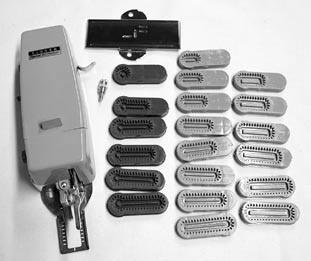More on Singer Buttonholers
by Charlene Phillps
ISMACS News 98
March 2010

(Left) Singer buttonholer(right) the Professional
Martin Gregory's article on Singer's 1950s buttonholer (ISMACS News #97), leads me neatly to the 'next generation' of Singer buttonholers, the Professional, and several points to consider before purchasing a buttonholer for vintage sewing machines.
The Professional differs from previous Singer buttonholers in several ways. Earlier templates had been loaded from the bottom which meant that every time you changed one, the foot had to be removed. With the Professional, templates load from the top to make changing buttonhole styles much easier.
Along with shank markings on each buttonholer, the shank type of previous models had been distinguished by the color of the case: green for low shank; pink/maroon for slant shank. The buttonholers, too, appeared to be of differing colors for vertical and slant. Beginning with the Professional Buttonholer, cardboard boxes were used; marked for vertical- or for slant-needle zigzag machines.
The Professional buttonholer introduced templates made of plastic, instead of cast alloy, but you got more of them. Whereas the previous provided five templates (with four additional styles and an eyelet template in its own tiny little box, purchasable separately), the Professional came with twenty - ranging from 1/2" to 11/2" - eight various straight sizes, an eyelet template in it's own tiny little box, purchasable separately), the Professional came with twenty - ranging from 1/2" to 1 1/2" - eight various straight sizes, an eyelet template, five keyhole sizes and six different bound buttonhole templates. By this time, Singer had manufactured several styles of needle plate for their slant shank machines. Earlier buttonholers had used the same feed cover plate regardless of machine model but, from the Professional onwards, feed cover plates were matched to the style of needle plate. No fudging on this one!
| Name |
Part Number | Description | Machine type |
|---|---|---|---|
| Singer buttonholer - older style (c. 1930s-40s) |
160743 | Slant shank - black and silver, comes with 5 templates in straight and keyhole; one type of feed cover plate; maroon, oblong plastic case. |
Straight stitch |
| Singer buttonholer - older style (c. 1930s-40s) |
160506 | Low shank - black and silver, incl. 5 templates in straight & keyhole; one type of feed cover plate; green, oblong plastic case. |
Straight stitch |
| Singer buttonholer (1950s-60s) |
489510 | Slant shank - incl. 5 templates in straight and keyhole, comes in pink "space ship/Jetson" case; one type of feed cover plate. |
Straight stitch |
| Singer buttonholer (1950s-60s) |
489500 | Low shank - incl. 5 templates in straight and keyhole, comes in jade green "space ship/Jetson" case; one type of feed cover plate. |
Straight stitch |
| Professional buttonholer (1960s-70s) |
381116 (116327 for Touch & Sew) |
Slant shank – incl. 20 templates in straight, keyhole, bound buttonholes, eyelet & straight, cardboard attachment box; feed plate differs by machine |
Zigzag |
| Professional buttonholer (1960s and 70s) |
v102878 | Low shank – incl. 20 templates in straight keyhole, bound buttonholes, eyelet, and straight; cardboard attachment box; feed plate differs by machine |
Zigzag |

The Singer Professional complete
While vertical needle (low shank) machines continued to use the same type of feed cover plate, slant-needle machines used one of two styles: #161825 was for elevator throat plate machines (e.g. 401, 500, 600, 620, 630, and 640 series). #507661 (or replacement #381115) was for Touch & Sew machines with magnetic throat plates (700, 900 series and Futura). It is interesting to note that the same feed cover plates can be used for the Singer Monogrammer.
Before using a buttonholer it is important to know several bits of information. Is your sewing machine vertical shank (low) or slant shank? Is it straight stitch or zigzag? Straight stitch machines can only use the straight stitch buttonholer but, with zigzag capabilities, you can choose either. Earlier buttonholers moved back and forth to create the zigzag stitch for the buttonhole, but the Professional utilizes the machine's zigzag function.
For a collector of buttonholers, Singer offers a wealth of choices. From the earliest - made for the VS2 - to the Complete, through the Professional and beyond. Add to them the models made in Europe, such as the red and cream Complete, and you will have a nice sized collection.
Charlene is the author of The Sewing Machine Attachment Handbook
If you have any information to add, or additional part numbers for any of the buttonholers, please email Charlene. Also, if you would like a copy of her guide for the Singer Professional Buttonholer and Monogrammer, contact her at [email protected] or download it from http://www.thesewbox.com/free_sewing_ machine_instructions.html (Singer Monogrammer and Buttonholer Plates).





